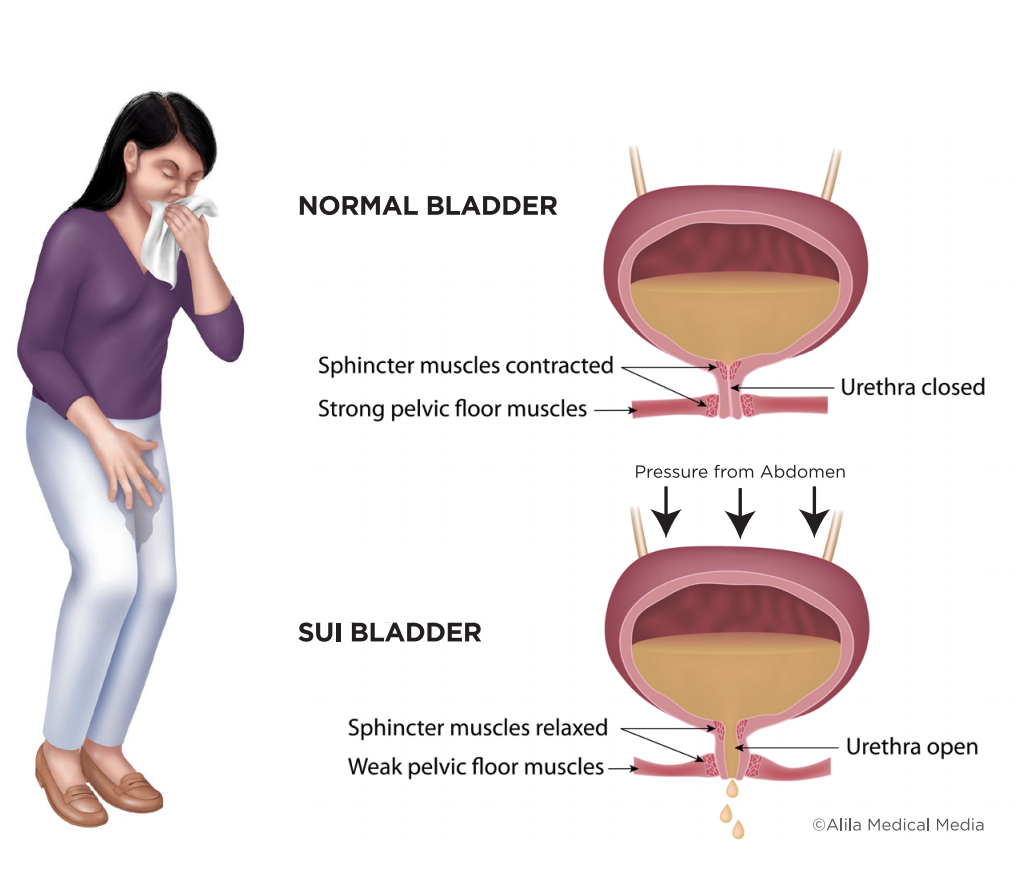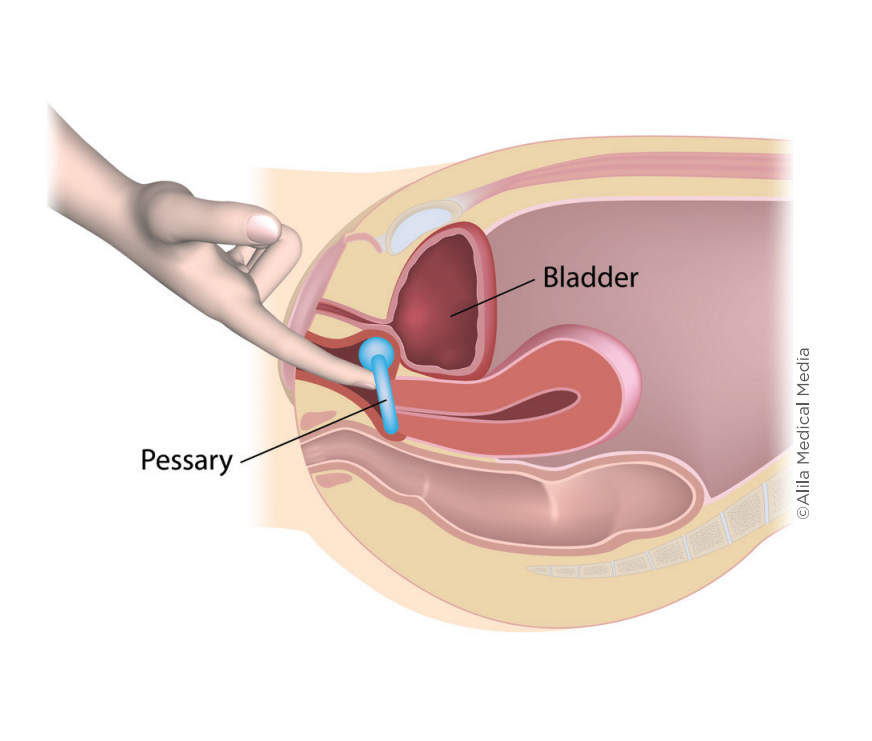Stress urinary incontinence (SUI) is the loss of urine that occurs at the same time as physical exertion. Activities like sneezing, coughing, or exercise increase the pressure or “stress” on the bladder. This pushes urine out of the body.
About SUI
SUI affects one in three women over 45 years old. Women most commonly develop SUI from changes that happen during pregnancy or childbirth which weaken the normal bladder support to the urethra. Chronic coughing, constipation, obesity, aging, smoking, or extreme weight lifting can also cause SUI. Genetics may also play a role.
The bladder walls are made of muscles. As urine flows into the bladder, the walls expand to make room for more fluid, like a water balloon. Sudden pressure caused by activity or “stress” unintentionally pushes urine through the urethra, the tube that carries urine out of the body.
Some women occasionally leak, for example, only with intense exercise, heavy coughing, or when their bladder is very full. Others leak with activities such as walking or laughing. Women may limit physical and social activities to avoid SUI. There is no need to do this! Speak with your medical provider about treatments that can help.
DIAGNOSIS
There are different kinds of urine leakage. To diagnose your problem, you will be asked questions about when and how often you leak urine. A physical exam will help identify other conditions that influence the bladder, such as pelvic organ prolapse. As part of the exam, you will be asked to cough or strain with a full bladder to see if you leak.
Additional tests might include:
• Urine analysis to check for a urinary tract infection and blood in your urine.
• Ultrasound to assess how much urine remains in your bladder after urinating.
• Urodynamics tests to provide information on your bladder and urethra.
You may be asked to complete a bladder diary. This requires you to record what, how much, and how often you drink. You also measure the amount you urinate. This will help your provider learn more about your bladder symptoms.
LEARN THE TERMS
Stress urinary incontinence (SUI): Urine leakage with physical activity such as laughing, sneezing, lifting, or exercise.
Urinary urgency incontinence (UUI): Urinary leakage that occurs with the sudden, strong desire to pass urine.
Pelvic organ prolapse (POP): Dropping of the pelvic organs, such as the bladder, uterus, and rectum, caused by a loss of vaginal support.
Urethra: Tube from the bladder to the outside of the body that urine passes through during urination.
Mid-urethral sling: Placement of synthetic mesh in a strap-like fashion under the urethra to treat SUI symptoms.
Urethral suspension (Burch suspension): Suspension of the bladder with stitches placed near the urethra to treat SUI.
Urodynamics: A group of tests performed in the office using a machine to evaluate how well your bladder fills and empties.
TREATMENTS
The ideal SUI treatment depends on your symptoms and impacts to your lifestyle. You may want to first try conservative treatments such as lifestyle changes, pelvic floor muscle exercises, or a vaginal pessary. There are no medicines that help this problem.
LIFESTYLE CHANGES
There are lifestyle changes you can embrace to reduce symptoms:
• Keep your bladder empty. Try to urinate every 2 to 3 hours.
• Maintain your weight in a normal range. It will be helpful to lose weight if you are overweight.
• Quit smoking.
• Treat constipation and stop straining with bowel movements.
• Stop extreme weight lifting activities and avoid repeated heavy lifting.
PELVIC FLOOR PHYSICAL THERAPY
Most women find that pelvic floor muscle exercises (Kegels) help improve symptoms. For the best effect, work with a specialized physical therapist to learn the techniques. Ask your provider for a referral. Then use these exercises every time you feel a cough or sneeze coming. It may take 3 to 6 months of regular pelvic floor muscle exercise to see results.
VAGINAL PESSARY
A pessary is a silicone device inserted into the vagina. It is similar to a diaphragm. Pessaries push the urethra closed to help control urine leakage. They still allow you to urinate normally when you need to. Some women wear a pessary only when they exercise. Others leave it in all the time.
URETHRAL BULKING AGENTS
In this procedure, a substance is injected near the urethra to “bulk up” the walls. This works well when a sphincter muscle that circles the urethra weakens. There are different types of bulking agents. This outpatient procedure is usually done in the office. It is low risk and allows you to continue to be active immediately, but wears off after several months. The injections will need to be repeated.
SURGERY
SUI surgery addresses the weakened supports around the urethra. There are different SUI surgeries, including mid-urethral slings and urethral suspensions. Surgery is typically very successful and often low risk. Not all women are candidates for surgery. Women who plan to get pregnant may want to wait until after their last pregnancy to have SUI surgery. Your provider will discuss each of these options with you to help tailor the best treatment for your specific condition.
THREE TAKEAWAYS
1. SUI is common but not normal, and can be successfully treated so you can resume your active life!
2. Non-surgical options like lifestyle changes, pelvic floor muscle exercises, and pessaries can manage symptoms.
3. There are several successful surgeries to treat SUI. Ask your provider if you are a good match for surgery.






